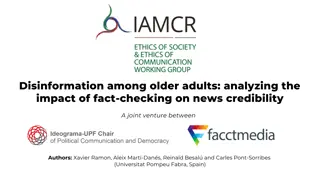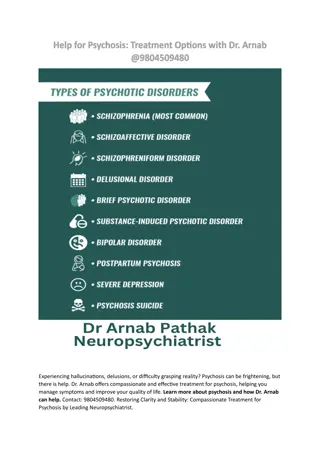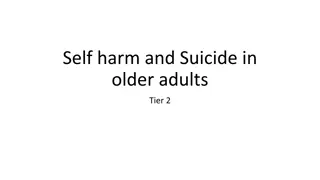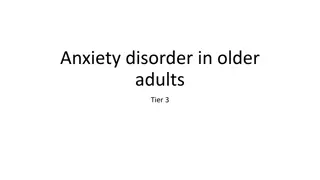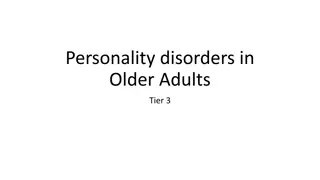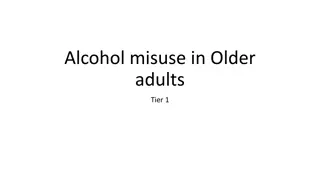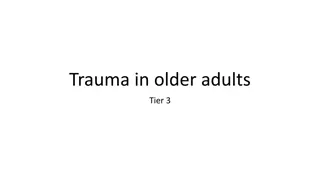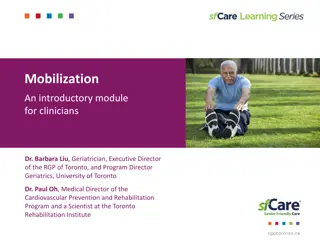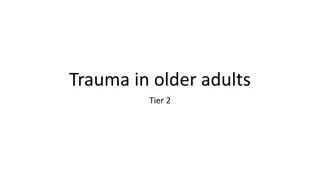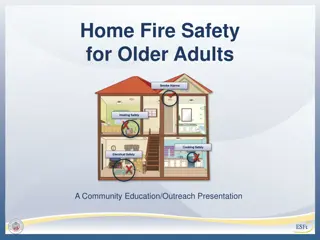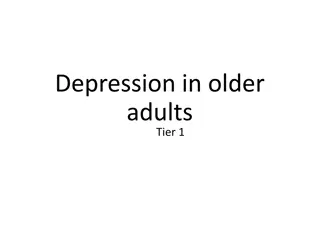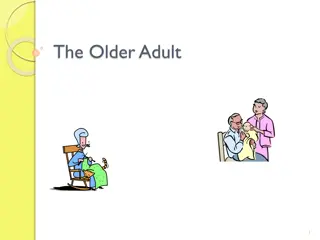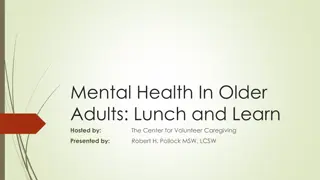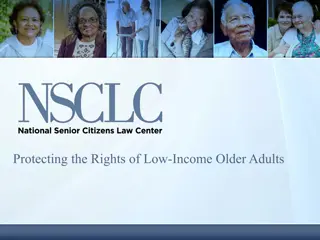Understanding Psychosis in Older Adults
Psychosis in older adults presents unique challenges due to varied etiology, different presentations, and higher associated morbidity. Causes include medical conditions, psychiatric disorders, and certain medications. Delirium, depression, and dementia are common contributors to psychosis in the elderly population.
Download Presentation

Please find below an Image/Link to download the presentation.
The content on the website is provided AS IS for your information and personal use only. It may not be sold, licensed, or shared on other websites without obtaining consent from the author. Download presentation by click this link. If you encounter any issues during the download, it is possible that the publisher has removed the file from their server.
E N D
Presentation Transcript
Psychosis in older adults Tier 3
Psychosis What is psychosis? Some loss of contact with reality . This might involve hallucinations or delusions (NHS) Hallucinations hearing voices/ seeing things/ sensation that someone is touching them/ experiencing smells that are not there Delusions- unshakeable belief in something untrue When you perceive or interpret reality in a very different way from people around you. You might be said to 'lose touch' with reality. (MIND)
Symptoms of Psychosis Variable experiences depending upon the person and can include: Hallucinations Delusions Disordered or confused thoughts Disorganised behaviours Negative symptoms (reduction in motivation ,interest and or verbal expression) The person is usually unaware that the experiences are not real
Psychosis in older adults Psychosis in older adults is: Common Has varied aetiology Older adults with psychosis have varied presentations Prognosis is different to younger adults with psychosis Associated morbidity and mortality is high Higher rate of adverse effects from treatment
A comparison of the defining characteristics Early- Onset Schizophrenia, Late-Onset Disease, and Very Late-Onset Schizophrenia-Like Psychosis
Causes of psychosis in older adults Secondary to Medical or Organic causes: Delirium Neuropsychiatric conditions (e.g. stroke, MS, epilepsy, encephalitis) Certain prescribed medications Alcohol and drug misuse/ withdrawals Dementia Alzheimer s Lewy body Vascular Primary psychiatric causes Schizophrenia Very-late onset schizophrenia like psychosis (VLOSLP) Delusional disorder Schizoaffective Depression Bipolar affective disorder
Other conditions causing psychosis Older adults with Delirium have high rates of psychosis (42%) visual>auditory hallucinations Older adults with depression have higher rates of psychosis, delusions>hallucinations. Older adults with dementia have high rate of psychosis AD (41%) VD (15%) LBD (up to 78%) Older adults have higher incidence of secondary psychosis
Assessment Assessment of psychosis in older adults Is it new onset or consistent with past mental health presentation Rule out Delirium and other physical causes Medical history including prescription medications Investigations: FBC, U&E, CRP, LFT, VIT B12, Urine dip, CXR, CT / MRI head Assess for dementia and Primary Psychiatric causes Careful history taking Collateral information Mental state examination Functional assessments Cognitive assessments
Very late Onset Schizophrenia like Psychosis (VLOSP) More likely to have Persecutory and misidentification delusions Partition delusions 3rdperson, running commentary and accusatory or abusive auditory hallucinations Visual, tactile and olfactory hallucinations Less likely to have Formal thought disorder Affective flattening or blunting Family history VLOSLP tends to occurs more in Females than Males and they often have hearing impairment It is worth encouraging them to have treatment with low dose of atypical antipsychotics as it can be effective and improve their quality of life
Treatment Following treatment considerations should be kept in mind when treating psychosis in older adults Typical antipsychotics: high rate of Extra pyramidal side effects Atypical antipsychotic: high rate of metabolic disturbance and anticholinergic burden All antipsychotics increase risk of stroke and cardiac arrhythmias which can lead to sudden death Individual risk benefit analysis Typically starting dose for adults Gradual titration Use lowest doses and regular reviews
Take home points Psychosis can occur in older adults Take a detailed history Make sure you exclude a physical health cause for the symptoms Think about VLOSLP as a possible diagnosis Antipsychotics can work very well in these patients Low dose and slow titration is necessary, with early reviews Use of antipsychotics can however increase physical health risks such as strokes and cardiac arrhythmias leading to death
References and Resources https://www.ncbi.nlm.nih.gov/pmc/articles/PMC181181/ MPC_04_04 Other People Tell Me I'm Seeing Things | Other People Tell Me I'm Seeing Things (mindedforfamilies.org.uk) This is an easy to access website for older adults and their families which has good advice about symptoms and treatment of hallucinations in older adults


